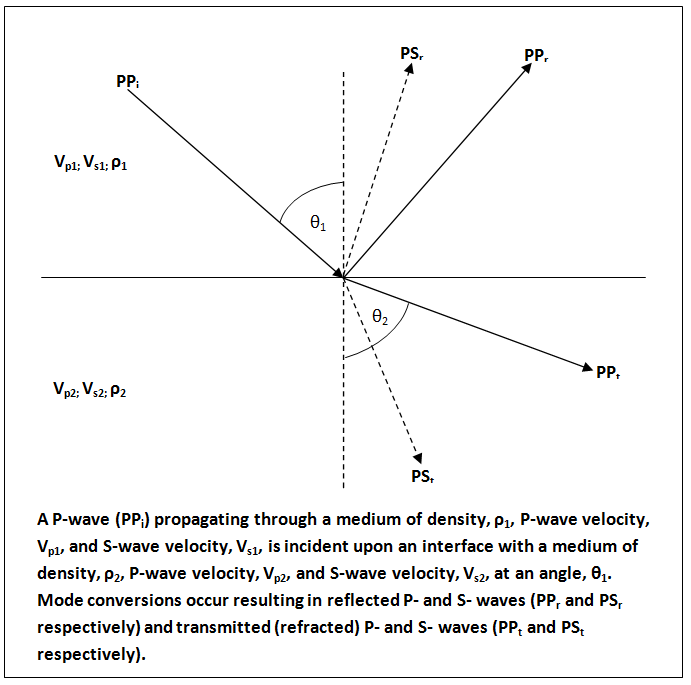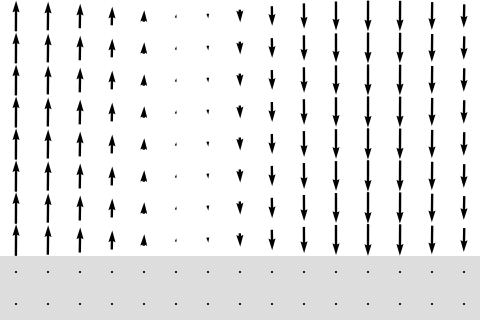|
Karl Bernhard Zoeppritz
Karl Bernhard Zoeppritz (22 October 1881 – 20 July 1908) was a German geophysicist who made important contributions to seismology, in particular the formulation of the Zoeppritz equations. These equations relate the amplitudes of P-waves and S-waves at each side of an interface, between two arbitrary Deformation (engineering)#Elastic deformation, elastic media, as a function of the angle of incidence (optics), angle of incidence and are largely used in reflection seismology for determining structure and properties of the subsurface. Early life Zoeppritz was born on 22 October 1881 in Mergelstetten, a small village several miles south of Heidenheim an der Brenz. He studied natural science and geology at the universities of University of Munich, Munich and University of Freiburg, Freiburg, finishing his education with a doctoral dissertation on the geology of part of the Swiss Alps in 1905, at the University of Freiburg. Following the completion of his doctorate, in the summer of ... [...More Info...] [...Related Items...] OR: [Wikipedia] [Google] [Baidu] |
Heidenheim An Der Brenz
Heidenheim an der Brenz, or just Heidenheim (; Swabian: ''Hoidna'' or ''Hoirna''), is a town in Baden-Württemberg in southern Germany. It is located near the border with Bavaria, approximately 17 km south of Aalen and 33 km north of Ulm. Heidenheim is the largest town and the seat of the district of Heidenheim, and ranks third behind Aalen and Schwäbisch Gmünd in size among the towns in the region of East Württemberg. Heidenheim is the economic center for all the communities in Heidenheim district and is the headquarters of the Voith industrial company. The town's population passed the 20,000 mark in 1925. Heidenheim collaborates with the town of Nattheim in administrative matters. The residents of Heidenheim and its surrounding area speak the distinct German dialect of Swabian. Geography Heidenheim is situated between Albuch and the Härtsfeld region in the northeast corner of the Swabian Alb where the valley of the Brenz meets the Stubental at the foot ... [...More Info...] [...Related Items...] OR: [Wikipedia] [Google] [Baidu] |
1905 Calabria Earthquake
Striking southern Italy on September 8, the 1905 Calabria earthquake had a moment magnitude of 7.2 and a maximum Mercalli intensity of XI (''Extreme''). The first major earthquake of the 20th century, it severely damaged parts of Lipari, Messina Province and a large area between Cosenza and Nicotera and killed between 557 and 2,500 people. Damage The earthquake affected the Calabria region, destroying as many as 25 villages, and 14,000 homes. See also * List of earthquakes in 1905 * List of earthquakes in Italy References External links M 7.2 - Sicily, Italy– United States Geological Survey The United States Geological Survey (USGS), formerly simply known as the Geological Survey, is a scientific agency of the United States government. The scientists of the USGS study the landscape of the United States, its natural resources, ... * {{DEFAULTSORT:Calabria earthquake 1905 earthquakes 1905 Calabria 1905 in Italy 1905 in science History of Calabria 1905 t ... [...More Info...] [...Related Items...] OR: [Wikipedia] [Google] [Baidu] |
Hydrocarbon Exploration
Hydrocarbon exploration (or oil and gas exploration) is the search by petroleum geologists and geophysicists for deposits of hydrocarbons, particularly petroleum and natural gas, in the Earth using petroleum geology. Exploration methods Visible surface features such as oil seeps, natural gas seeps, pockmarks (underwater craters caused by escaping gas) provide basic evidence of hydrocarbon generation (be it shallow or deep in the Earth). However, most exploration depends on highly sophisticated technology to detect and determine the extent of these deposits using exploration geophysics. Areas thought to contain hydrocarbons are initially subjected to a gravity survey, magnetic survey, passive seismic or regional seismic reflection surveys to detect large-scale features of the sub-surface geology. Features of interest (known as ''leads'') are subjected to more detailed seismic surveys which work on the principle of the time it takes for reflected sound waves to travel throu ... [...More Info...] [...Related Items...] OR: [Wikipedia] [Google] [Baidu] |
Amplitude Versus Offset
In geophysics and reflection seismology, amplitude versus offset (AVO) or amplitude variation with offset is the general term for referring to the dependency of the seismic attribute, amplitude, with the distance between the source and receiver (the offset). AVO analysis is a technique that geophysicists can execute on seismic data to determine a rock's fluid content, porosity, density or seismic velocity, shear wave information, fluid indicators (hydrocarbon indications). The phenomenon is based on the relationship between the reflection coefficient and the angle of incidence and has been understood since the early 20th century when Karl Zoeppritz wrote down the Zoeppritz equations. Due to its physical origin, AVO can also be known as amplitude versus angle (AVA), but AVO is the more commonly used term because the offset is what a geophysicist can vary in order to change the angle of incidence. (See diagram) Background and theory For a seismic wave reflecting off an inte ... [...More Info...] [...Related Items...] OR: [Wikipedia] [Google] [Baidu] |
Knott's Equations
In geophysics, Knott's equations were the first equations to describe the amplitudes of reflected and refracted waves generated at non-normal incidence upon an interface. Sheriff, R. E., Geldart, L. P., (1995), 2nd Edition. Exploration Seismology. Cambridge University Press. They were derived in 1899 by the British geophysicist Cargill Gilston Knott using displacement potential functions C. G. Knott (1899Reflection and Refraction of Elastic Waves with Seismological Applications Philosophical Magazine 48: 64–97 via Biodiversity Heritage Library and describe the same phenomenon that the Zoeppritz equations In geophysics and reflection seismology, the Zoeppritz equations are a set of equations that describe the partitioning of seismic wave energy at an interface, due to mode conversion. They are named after their author, the German geophysicist Karl ... describe in terms of amplitude displacements. References {{reflist Seismology measurement Petroleum geology ... [...More Info...] [...Related Items...] OR: [Wikipedia] [Google] [Baidu] |
Cargill Gilston Knott
Cargill Gilston Knott FRS, FRSE LLD (30 June 1856 – 26 October 1922) was a Scottish physicist and mathematician who was a pioneer in seismological research. He spent his early career in Japan. He later became a Fellow of the Royal Society, Secretary of the Royal Society of Edinburgh, and President of the Scottish Meteorological Society. Biography Knott was born in Penicuik, Midlothian, the son of Pelham Knott, an agent for a paper manufacturer and his wife Ellen. His paternal uncle was the artist Tavernor Knott. He was educated at Arbroath High School in Angus, and attended the University of Edinburgh, where he studied alongside James Alfred Ewing. He worked on various aspects of electricity and magnetism, obtaining his doctorate in 1879. He was appointed as an assistant in Natural Philosophy at the University of Edinburgh in 1879, and held this post until 1883, when he left to take up a post at Tokyo Imperial University. He was elected as a Fellow of the Royal Society of ... [...More Info...] [...Related Items...] OR: [Wikipedia] [Google] [Baidu] |
Gustav Herglotz
Gustav Herglotz (2 February 1881 – 22 March 1953) was a German Bohemian physicist best known for his works on the theory of relativity and seismology. Biography Gustav Ferdinand Joseph Wenzel Herglotz was born in Volary num. 28 to a public notary Gustav Herglotz (also a Doctor of Law) and his wife Maria née Wachtel. The family were Sudeten Germans. He studied mathematics and astronomy at the University of Vienna in 1899, and attended lectures by Ludwig Boltzmann. In this time of study, he had a friendship with his colleagues Paul Ehrenfest, Hans Hahn and Heinrich Tietze. In 1900 he went to the LMU Munich and achieved his Doctorate in 1902 under Hugo von Seeliger. Afterwards, he went to the University of Göttingen, where he habilitated under Felix Klein. In 1904 he became Privatdozent for Astronomy and Mathematics there, and in 1907 Professor extraordinarius. In 1908 he became Professor extraordinarius in Vienna, and in 1909 at the University of Leipzig. From 1925 (until becom ... [...More Info...] [...Related Items...] OR: [Wikipedia] [Google] [Baidu] |
Inverse Problem
An inverse problem in science is the process of calculating from a set of observations the causal factors that produced them: for example, calculating an image in X-ray computed tomography, source reconstruction in acoustics, or calculating the density of the Earth from measurements of its gravity field. It is called an inverse problem because it starts with the effects and then calculates the causes. It is the inverse of a forward problem, which starts with the causes and then calculates the effects. Inverse problems are some of the most important mathematical problems in science and mathematics because they tell us about parameters that we cannot directly observe. They have wide application in system identification, optics, radar, acoustics, communication theory, signal processing, medical imaging, computer vision, geophysics, oceanography, astronomy, remote sensing, natural language processing, machine learning, nondestructive testing, slope stability analysis and man ... [...More Info...] [...Related Items...] OR: [Wikipedia] [Google] [Baidu] |
Herbert Hall Turner
Herbert Hall Turner (13 August 1861 – 20 August 1930) was a British astronomer and seismologist. Biography Herbert Hall Turner was educated at the Leeds Modern School, Clifton College, Bristol and Trinity College, Cambridge. In 1884 he accepted the post of Chief Assistant at the Royal Greenwich Observatory and stayed there for nine years. In 1893 he became Savilian Professor of Astronomy and Director of the Radcliffe Observatory at Oxford University, a post he held for 37 years until his sudden death in 1930. He was one of the observers in the Eclipse Expeditions of 1886 and 1887. In seismology, he is credited with the discovery of deep focus earthquakes. He is also credited with coining the word ''parsec''. His 1897 Royal Society candidature citation read: " '' Secretary of the Royal Astronomical Society. Was Chief Assistant at the Royal Observatory, Greenwich 1884-1894. Author of various papers among which may be mentioned:- * "''On the correction of the Equilibri ... [...More Info...] [...Related Items...] OR: [Wikipedia] [Google] [Baidu] |
Beno Gutenberg
Beno Gutenberg (; June 4, 1889 – January 25, 1960) was a German-American seismologist who made several important contributions to the science. He was a colleague and mentor of Charles Francis Richter at the California Institute of Technology and Richter's collaborator in developing the Richter magnitude scale for measuring an earthquake's magnitude. Early life, family and education Gutenberg was born in Darmstadt, Germany. His father owned a factory. He obtained his doctorate in physics from the University of Göttingen in 1911. His advisor was Emil Wiechert. Career During World War I, Gutenberg served in the German Army as a meteorologist in support of gas warfare operations. Gutenberg held positions at the University of Strasbourg, which he lost when Strasbourg became French in 1918. After some years during which he had to sustain himself with managing his father's soap factory, he obtained in 1926 a junior professorship at University of Frankfurt-am-Main, which was ... [...More Info...] [...Related Items...] OR: [Wikipedia] [Google] [Baidu] |
Body Wave (seismology)
{{disambig ...
Body wave may refer to one of the following: *Body wave (seismology), a type of seismic wave *Body wave (dance move) *Body wave (hair style) *Body wave (locomotion), also called undulatory locomotion, in animals *''Body Waves'', a 1992 comedy film directed by P.J. Pesce P. J. Pesce is an American film director and writer. He is also the co-creator of the MTV cartoon '' The Adventures of Chico and Guapo'', as well as the voice actor of Guapo and Mr. Angelo. Early life and education Pesce was born and raised in ... [...More Info...] [...Related Items...] OR: [Wikipedia] [Google] [Baidu] |
Surface Waves
In physics, a surface wave is a mechanical wave that propagates along the interface between differing media. A common example is gravity waves along the surface of liquids, such as ocean waves. Gravity waves can also occur within liquids, at the interface between two fluids with different densities. Elastic surface waves can travel along the surface of solids, such as '' Rayleigh'' or ''Love'' waves. Electromagnetic waves can also propagate as "surface waves" in that they can be guided along with a refractive index gradient or along an interface between two media having different dielectric constants. In radio transmission, a ''ground wave'' is a guided wave that propagates close to the surface of the Earth. Mechanical waves In seismology, several types of surface waves are encountered. Surface waves, in this mechanical sense, are commonly known as either ''Love waves'' (L waves) or ''Rayleigh waves''. A seismic wave is a wave that ''travels through the Earth, often as the r ... [...More Info...] [...Related Items...] OR: [Wikipedia] [Google] [Baidu] |






